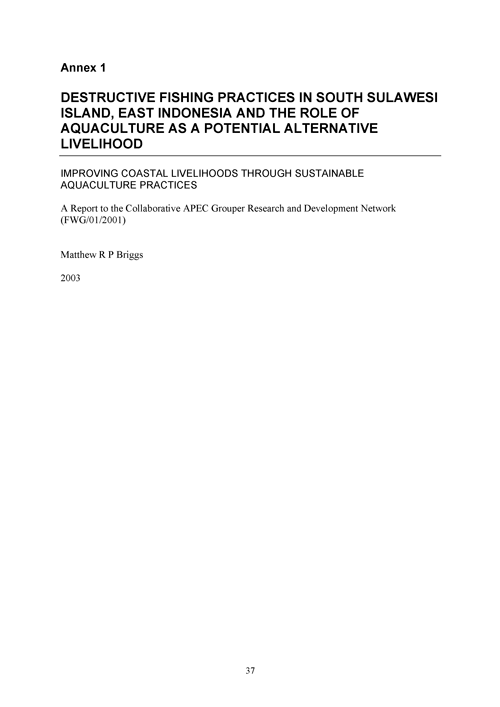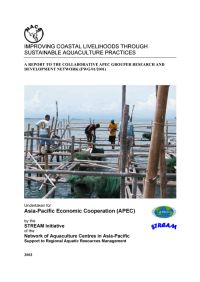Destructive fishing practices in south Sulawesi Island, East Indonesia, and the role of aquaculture as a potential alternative livelihood
3 February 2004 | Matthew Briggs | 4313 Downloads | .pdf | 582.74 KB | Crabs and lobsters, Freshwater finfish, Gender, Genetics and Biodiversity, Indonesia, Inland aquaculture, Livelihoods, gender and social issues, Aquatic plants, Marine finfish, Molluscs (shellfish and other), Shrimp
Because fisheries have inescapable ecosystem impacts, the task of finding the balance between promoting fishing to make the fullest contribution possible to development and food security – without perturbing marine ecosystems unsustainably – may be one of the most difficult challenges to sustainable development. A historical lack of effective integrated coastal and marine management in Indonesia has resulted in competition for limited resources, environmental degradation, over-fishing and poverty for small-scale fisherfolk.
Under a reorganisation of the Indonesian government in 1999, the Ministry of Marine Affairs and Fisheries (MMAF) was founded to help shift emphasis towards improving the quality of life of fisherfolk through the coastal community economic empowerment plan and decentralisation of the fisheries sector. Out of a total US$ 168 million budget for 2003, 85% will be decentralised to district and provincial governments. US$ 42 million (25%) of this is earmarked for income-generating activities and infrastructure development. MMAF is charged with encouraging small-medium-scale enterprises, including aquaculture, and the breaking of indebtedness through the provision of capital (mainly revolving funds), markets and technology, law enforcement and fostering community-based resource management.
Increasing population pressures, the Asian financial crisis and traditionally migrant fisherfolk competing for open-access resources using increasingly destructive methods, have led to dramatic declines in coastal resources, particularly coral reefs and fish stocks throughout the Indonesian archipelago.
Indonesia has up to 86,000 km2 of coral reefs, more than 50% of the Southeast Asian and 14-18% of the world total. Its economic value has been estimated at US$ 1.6 billion/year, with a net present value of US$ 14 billion. More than half of Indonesian coral reefs are threatened by destructive fishing practices, including over-fishing, blast and cyanide fishing, inshore trawling, coral extraction and fine mesh nets. Together, destructive fishing practices have the potential to result in a net economic loss to Indonesia of US$ 170 million/year (mainly due to coastal protection, tourism and fisheries) over the next 20 years.
Blast or dynamite fishing has been used since the 1940s as a quick and easy way of catching food fish. It is accounting for losses of 3.75 m2 per 100 m2 of Indonesian coral reefs per year. The net economic loss to Indonesia over the next 20 years due to blast fishing has been estimated at more than US$ 570 million. Possibilities for control include bans on waterproof fuses, legislating tenure to local communities, education of fishers, enforcement of legislation, economic empowerment to break indebtedness and promotion of alternative livelihoods.
Cyanide fishing has been practiced since the 1980s for catching high-value reef fish for the live trade in food and aquaria. Cyanide use leads to the death of coral and associated reef-dwelling organisms, and is leading to the progressive over-fishing of high-value reef fish throughout Indonesia and beyond. The net economic loss to Indonesia over the next 20 years due to cyanide fishing has been estimated at greater than US$ 920 million. The live reef food fish trade based on cyanide is destructive and unsustainable and requires separate legislation and management. Key priorities include education of all parties involved, establishment of quotas and restrictions, obligatory reporting of captures and data management, stricter controls over cyanide use, eco-certification of aquacultured and cyanide-free fish, establishment of marine protected areas and seasonal or areal bans and the use of the CITES framework for monitoring and enforcing legislation.
Sulawesi has the largest coral reef area in Indonesia, at the epicenter of worldwide marine biodiversity, but is one of the areas most threatened in Southeast Asia by destructive fishing practices. Various coastal management projects have recently been or are being conducted in Sulawesi with varied, but occasionally encouraging, results. South Sulawesi has a large and growing marine fishery producing 306,000 mt worth US$ 133 million in 2001. The industry employs ever-increasing numbers of fishermen (up from 47,000 in 2000 to 60,000 in 2001), but diminishing average size and lack of high-value species indicate that serious over-fishing is occurring.
There are special problems related to traditional Indonesian fishermen fishing the MOU Box area of northwest Australia. What is required now is a coordinated effort between the Australian and Indonesian governments and local fisherfolk to educate, economically empower and develop alternative livelihoods (including, but not limited to, aquaculture) for the participants. Both governments have already agreed to this, but prompt action is required since the declining resources within the MOU Box are already forcing fishers into more destructive and/or illegal practices or out of fishing entirely.
Aquaculture has been prioritised by the Indonesian government to help economic growth, increase exports (shrimp, grouper and seaweed) and provide food for its people (tilapia and milkfish). South Sulawesi has many institutions to develop aquaculture, but little cooperation and even competition among them. Even so, the brackishwater culture of shrimp (Penaeus monodon), milkfish and seaweed headed an industry producing 112,000 mt worth US$ 169 million from 87,000 ha in 2001.
Any aquaculture activity planned as an alternative livelihood for coastal communities must be placed within the context of an integrated, community-based coastal management plan. This must include full discussion, education, empowerment and support of local communities, who must be given the right to own, manage and control their own resources so that they can conserve and utilise them sustainably.
Grouper culture is growing rapidly in Indonesia due to the success of the Gondol Research Institute for Mariculture (GRIM) in Bali, permitting the supply of hatchery-reared grouper fry to the on-growing industry. The industry may now produce as much as 3,000 mt worth up to US$ 20 million, although real data is scarce. In South Sulawesi, the industry remains small (
Grouper culture has benefits of high potential profitability, somewhat proven technology, reductions in the demand for wild seed and market-sized fish, and hence alternative livelihood and environmental benefits. However, there are many constraints to its suitability as an alternative livelihood for poor fisherfolk. These include the high technology, capital intensive and long-term payback characteristics of grouper farming, the difficulty of breaking indebtedness and persuading fisherfolk to change vocations, the lack of tenureship of resources, the difficulty and seasonality of maturation and larval rearing, the shortage of suitable sites and reliance on trash fish, the reduction in demand for wild seed limiting current livelihoods, and limitations on the current market, which is controlled by traders and wholesalers leading to unfair distribution of profits.
Measures required to promote grouper culture in Indonesia include an integrated coastal management policy, research and development of culture techniques (including pond culture of juveniles and adults), diversification of cultured species, economic and educational empowerment of coastal communities, assistance with disease control and nutritional requirements, and the development of marketing strategies for seed and market-sized fish to broaden the demand for cultured grouper.
Shrimp farming is currently on the decline throughout Indonesia. In order to maintain the industry, more research (especially into disease prevention) and support is required if the 100,000 people currently involved in the industry in South Sulawesi are not to be added to those seeking alternative livelihoods.
Milkfish culture, in both hatchery and on-growing phases offers potential livelihoods for coastal fisherfolk in South Sulawesi. Polyculture of milkfish and shrimp (and possibly tilapia) can help generate food and jobs for local people. Assistance is required in refining husbandry techniques aimed at improving the economics of milkfish farming.
Seaweed culture is a growing industry in South Sulawesi and Indonesia in general. It has the potential to provide sustainable livelihoods to many poor fisherfolk, especially women, and has been recognised and promoted as such by the government through the Indonesian Seaweed Association. Although currently not particularly profitable, further development of processing and marketing aspects should result in larger and more lucrative culture and capture industries in the future.
Other aquaculture-based alternative livelihood possibilities include seabass, lobsters, giant clams and other mollusks, tilapia, Siganids and coral reef organisms for the aquarium trade. Most of these and some other fish species have received attention, but have yet to be fully exploited in South Sulawesi.
Cyanide is commonly used to catch marine organisms for the US$ 200 million worldwide aquarium trade. The Marine Aquarium Council (MAC), together with various NGOs, are promoting efforts in Indonesia to introduce non-destructive fishing methods, introduce standards and eco-certify such organisms. Such schemes offer potential livelihoods to fisherfolk currently using unsustainable capture methods in this trade in South Sulawesi.
Fish Aggregation Devices (FADs) have been used to attract migratory pelagic fish species and increase local catches in demonstration projects off Komodo Island and in the Philippines. Fishermen in South Sulawesi have the necessary skills and could be encouraged to adopt such devices to provide employment, high income, and reduce destructive fishing practices.
The establishment of community-managed Marine Protected Areas (MPAs) within a coastal management plan (preferably including grouper spawning aggregations, source reefs and nursery areas) has the capacity to preserve local fishery resources and livelihoods, promote tourism and maintain biodiversity. Management should be entrusted to local communities, but supported by government, since, of the 6.2 million hectare of existing Indonesian MPAs, fewer than 3% of them are currently rated as being managed effectively.
Environmentally sustainable tourism, which is capable of sustaining the functions of the marine ecosystem, presents an increasingly important opportunity for alternative livelihood generation. This is particularly true for areas with limited natural resources. It must be well managed, however, and integrated within an overall coastal management plan to fulfill its potential.
Copyright, all rights reserved.

